Peugeot 308 SW BL 2011 Owner's Manual
Manufacturer: PEUGEOT, Model Year: 2011, Model line: 308 SW BL, Model: Peugeot 308 SW BL 2011Pages: 336, PDF Size: 21.26 MB
Page 151 of 336
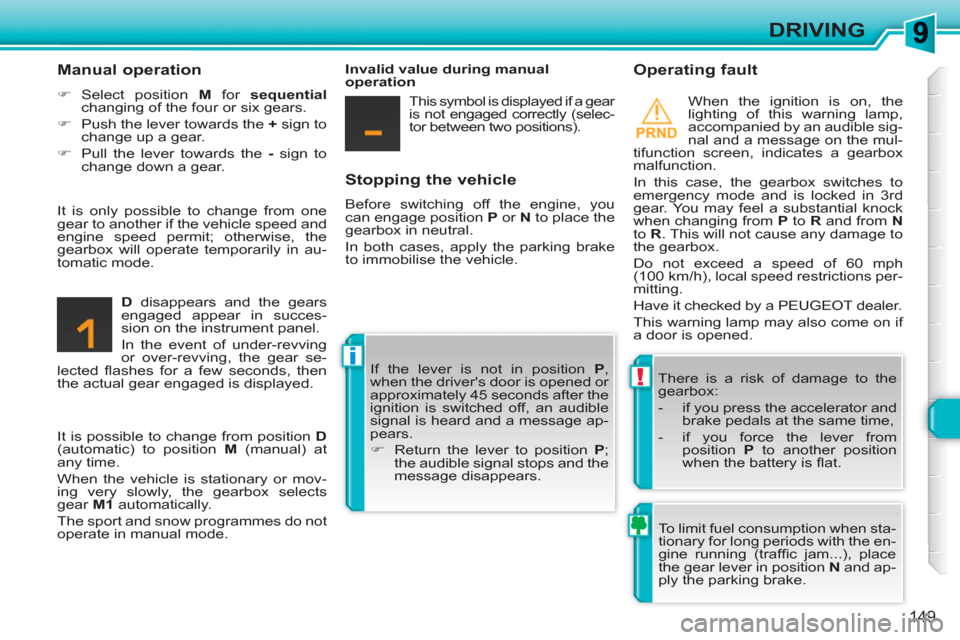
!
i
149
DRIVING
Stopping the vehicle
Before switching off the engine, you
can engage position P
or N
to place the
gearbox in neutral.
In both cases, apply the parking brake
to immobilise the vehicle.
Operating fault
When the ignition is on, the
lighting of this warning lamp,
accompanied by an audible sig-
nal and a message on the mul-
tifunction screen, indicates a gearbox
malfunction.
In this case, the gearbox switches to
emergency mode and is locked in 3rd
gear. You may feel a substantial knock
when changing from P
to R
and from N
to R
. This will not cause any damage to
the gearbox.
Do not exceed a speed of 60 mph
(100 km/h), local speed restrictions per-
mitting.
Have it checked by a PEUGEOT dealer.
This warning lamp may also come on if
a door is opened.
There is a risk of damage to the
gearbox:
- if you press the accelerator and
brake pedals at the same time,
- if you force the lever from
position P
to another position
when the battery is fl at.
Manual operation
�)
Select position M
for sequential
changing of the four or six gears.
�)
Push the lever towards the +
sign to
change up a gear.
�)
Pull the lever towards the -
sign to
change down a gear.
D
disappears and the gears
engaged appear in succes-
sion on the instrument panel.
In the event of under-revving
or over-revving, the gear se-
lected fl ashes for a few seconds, then
the actual gear engaged is displayed. If the lever is not in position P
,
when the driver's door is opened or
approximately 45 seconds after the
ignition is switched off, an audible
signal is heard and a message ap-
pears.
�)
Return the lever to position P
;
the audible signal stops and the
message disappears.
It is only possible to change from one
gear to another if the vehicle speed and
engine speed permit; otherwise, the
gearbox will operate temporarily in au-
tomatic mode.
Invalid value during manual
operation
This symbol is displayed if a gear
is not engaged correctly (selec-
tor between two positions).
It is possible to change from position D
(automatic) to position M
(manual) at
any time.
When the vehicle is stationary or mov-
ing very slowly, the gearbox selects
gear M1
automatically.
The sport and snow programmes do not
operate in manual mode. To limit fuel consumption when sta-
tionary for long periods with the en-
gine running (traffi c jam...), place
the gear lever in position N
and ap-
ply the parking brake.
Page 152 of 336
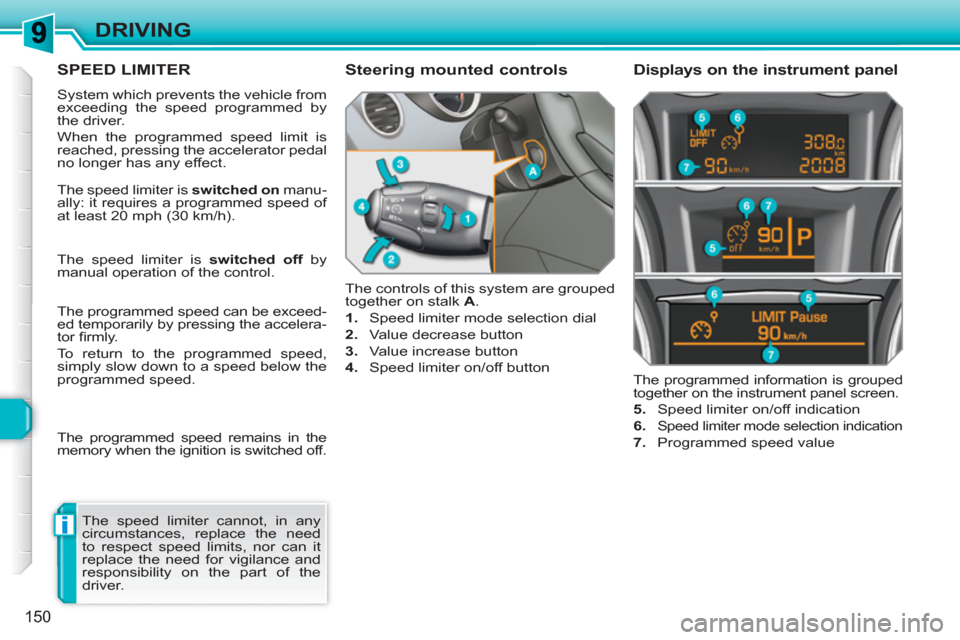
i
150
DRIVING
SPEED LIMITER
System which prevents the vehicle from
exceeding the speed programmed by
the driver.
When the programmed speed limit is
reached, pressing the accelerator pedal
no longer has any effect.
The controls of this system are grouped
together on stalk A
.
1.
Speed limiter mode selection dial
2.
Value decrease button
3.
Value increase button
4.
Speed limiter on/off button
The programmed information is grouped
together on the instrument panel screen.
5.
Speed limiter on/off indication
6.
Speed limiter mode selection indication
7.
Programmed speed value
Steering mounted controls
Displays on the instrument panel
The speed limiter cannot, in any
circumstances, replace the need
to respect speed limits, nor can it
replace the need for vigilance and
responsibility on the part of the
driver.
The speed limiter is switched on
manu-
ally: it requires a programmed speed of
at least 20 mph (30 km/h).
The speed limiter is switched off
by
manual operation of the control.
The programmed speed can be exceed-
ed temporarily by pressing the accelera-
tor fi rmly.
To return to the programmed speed,
simply slow down to a speed below the
programmed speed.
The programmed speed remains in the
memory when the ignition is switched off.
Page 153 of 336
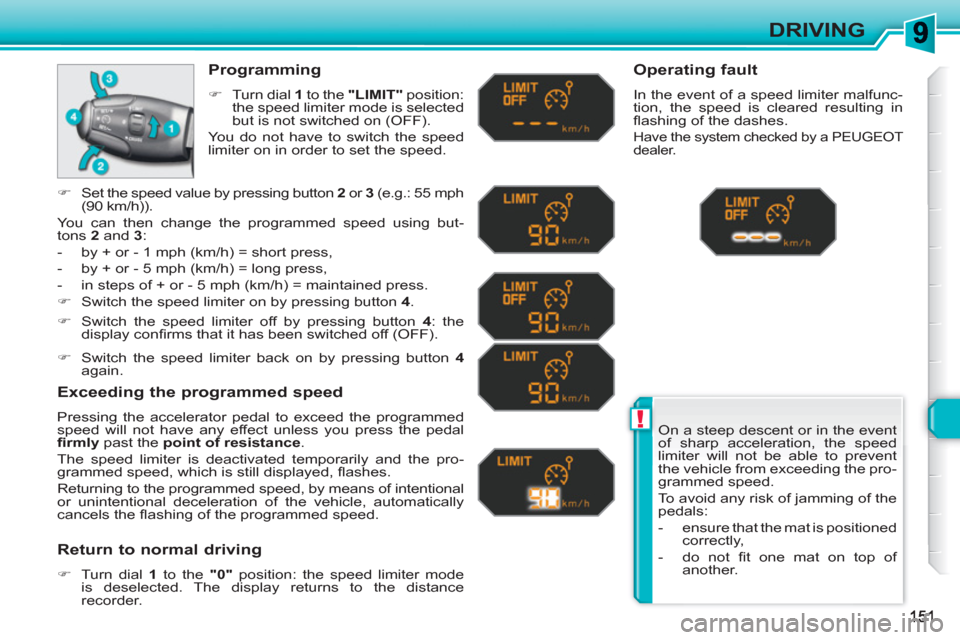
!
DRIVING
On a steep descent or in the event
of sharp acceleration, the speed
limiter will not be able to prevent
the vehicle from exceeding the pro-
grammed speed.
To avoid any risk of jamming of the
pedals:
- ensure that the mat is positioned
correctly,
- do not fi t one mat on top of
another.
Programming
�)
Turn dial 1
to the "LIMIT"
position:
the speed limiter mode is selected
but is not switched on (OFF).
You do not have to switch the speed
limiter on in order to set the speed.
Exceeding the programmed speed
Pressing the accelerator pedal to exceed the programmed
speed will not have any effect unless you press the pedal
fi rmly
past the point of resistance
.
The speed limiter is deactivated temporarily and the pro-
grammed speed, which is still displayed, fl ashes.
Returning to the programmed speed, by means of intentional
or unintentional deceleration of the vehicle, automatically
cancels the fl ashing of the programmed speed.
Return to normal driving
�)
Turn dial 1
to the "0"
position: the speed limiter mode
is deselected. The display returns to the distance
recorder.
Operating fault
In the event of a speed limiter malfunc-
tion, the speed is cleared resulting in
fl ashing of the dashes.
Have the system checked by a PEUGEOT
dealer.
�)
Switch the speed limiter off by pressing button 4
: the
display confi rms that it has been switched off (OFF).
�)
Switch the speed limiter back on by pressing button 4
again.
�)
Set the speed value by pressing button 2
or 3
(e.g.: 55 mph
(90 km/h)).
You can then change the programmed speed using but-
tons 2
and 3
:
- by + or - 1 mph (km/h) = short press,
- by + or - 5 mph (km/h) = long press,
- in steps of + or - 5 mph (km/h) = maintained press.
�)
Switch the speed limiter on by pressing button 4
.
Page 154 of 336
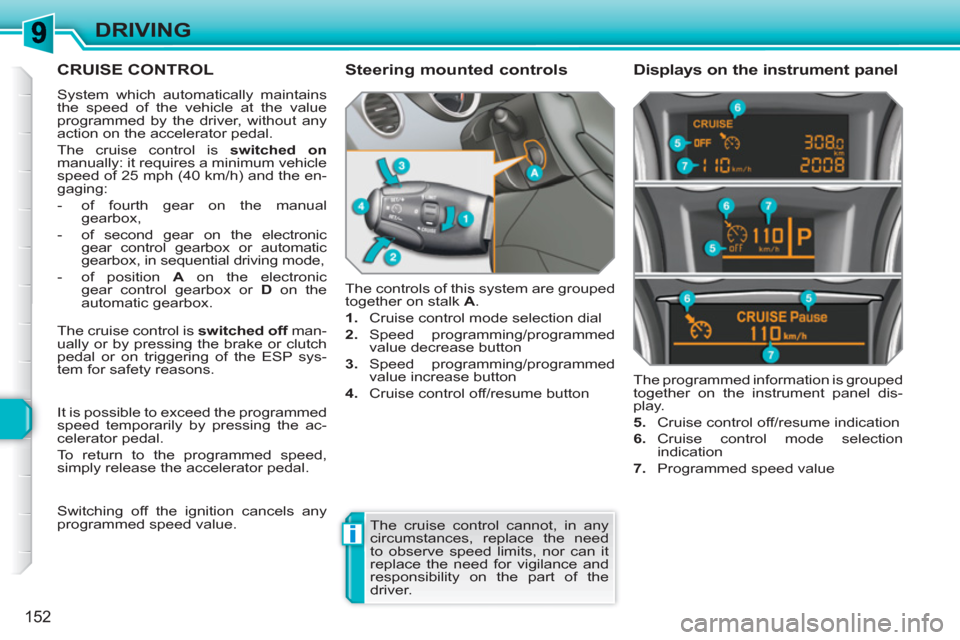
i
152
DRIVING
CRUISE CONTROL
System which automatically maintains
the speed of the vehicle at the value
programmed by the driver, without any
action on the accelerator pedal.
The cruise control is switched on
manually: it requires a minimum vehicle
speed of 25 mph (40 km/h) and the en-
gaging:
- of fourth gear on the manual
gearbox,
- of second gear on the electronic
gear control gearbox or automatic
gearbox, in sequential driving mode,
- of position A
on the electronic
gear control gearbox or D
on the
automatic gearbox. The controls of this system are grouped
together on stalk A
.
1.
Cruise control mode selection dial
2.
Speed programming/programmed
value decrease button
3.
Speed programming/programmed
value increase button
4.
Cruise control off/resume button The programmed information is grouped
together on the instrument panel dis-
play.
5.
Cruise control off/resume indication
6.
Cruise control mode selection
indication
7.
Programmed speed value
Steering mounted controls
Displays on the instrument panel
The cruise control cannot, in any
circumstances, replace the need
to observe speed limits, nor can it
replace the need for vigilance and
responsibility on the part of the
driver. The cruise control is switched off
man-
ually or by pressing the brake or clutch
pedal or on triggering of the ESP sys-
tem for safety reasons.
It is possible to exceed the programmed
speed temporarily by pressing the ac-
celerator pedal.
To return to the programmed speed,
simply release the accelerator pedal.
Switching off the ignition cancels any
programmed speed value.
Page 155 of 336
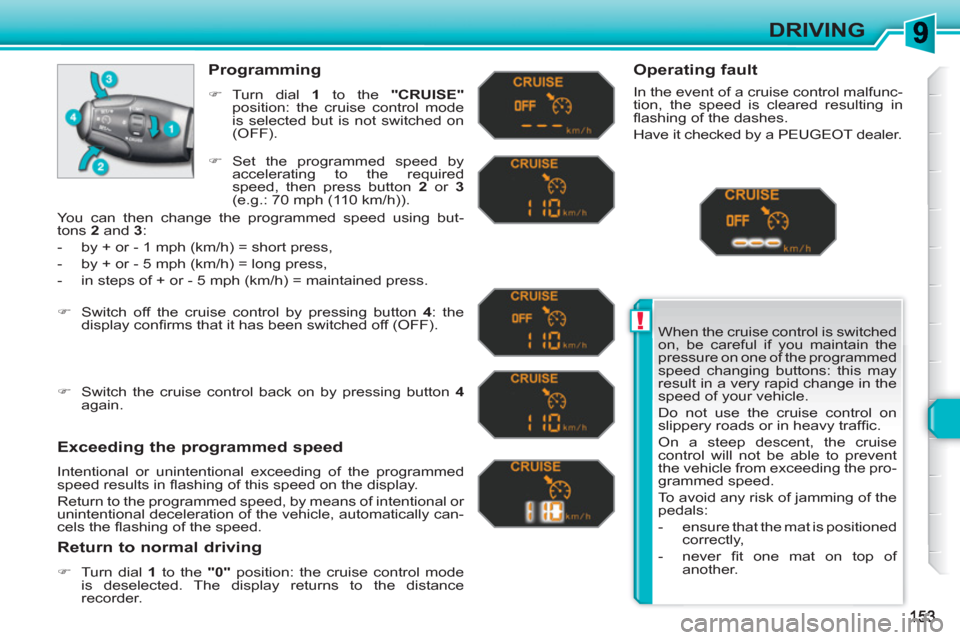
!
DRIVING
When the cruise control is switched
on, be careful if you maintain the
pressure on one of the programmed
speed changing buttons: this may
result in a very rapid change in the
speed of your vehicle.
Do not use the cruise control on
slippery roads or in heavy traffi c.
On a steep descent, the cruise
control will not be able to prevent
the vehicle from exceeding the pro-
grammed speed.
To avoid any risk of jamming of the
pedals:
- ensure that the mat is positioned
correctly,
- never fi t one mat on top of
another.
Programming
�)
Turn dial 1
to the "CRUISE"
position: the cruise control mode
is selected but is not switched on
(OFF).
Exceeding the programmed speed
Intentional or unintentional exceeding of the programmed
speed results in fl ashing of this speed on the display.
Return to the programmed speed, by means of intentional or
unintentional deceleration of the vehicle, automatically can-
cels the fl ashing of the speed.
Return to normal driving
�)
Turn dial 1
to the "0"
position: the cruise control mode
is deselected. The display returns to the distance
recorder.
Operating fault
In the event of a cruise control malfunc-
tion, the speed is cleared resulting in
fl ashing of the dashes.
Have it checked by a PEUGEOT dealer.
�)
Set the programmed speed by
accelerating to the required
speed, then press button 2
or 3
(e.g.: 70 mph (110 km/h)).
�)
Switch off the cruise control by pressing button 4
: the
display confi rms that it has been switched off (OFF).
�)
Switch the cruise control back on by pressing button 4
again.
You can then change the programmed speed using but-
tons 2
and 3
:
- by + or - 1 mph (km/h) = short press,
- by + or - 5 mph (km/h) = long press,
- in steps of + or - 5 mph (km/h) = maintained press.
Page 156 of 336
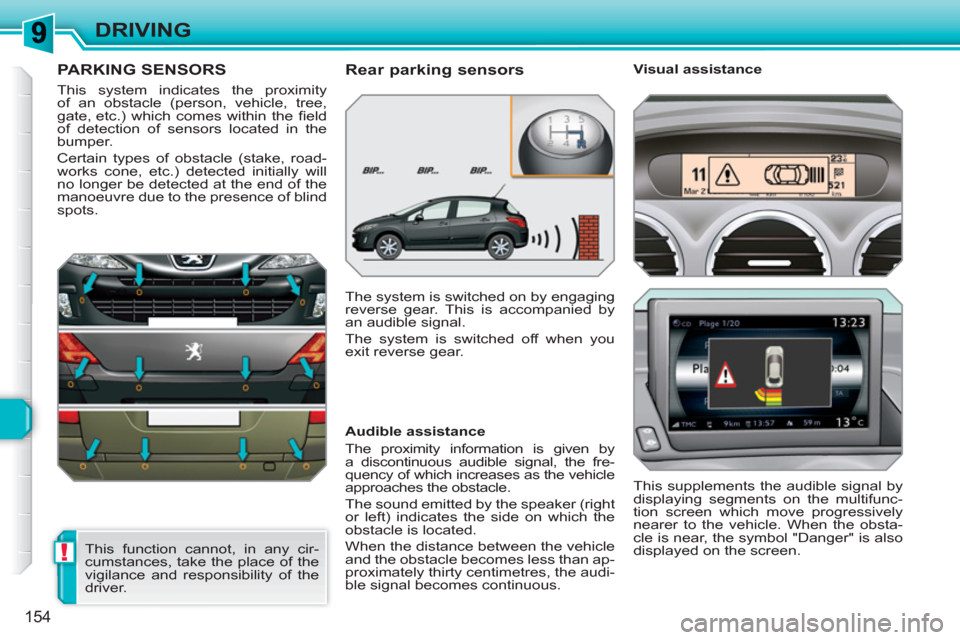
!
154
DRIVING
PARKING SENSORS
This system indicates the proximity
of an obstacle (person, vehicle, tree,
gate, etc.) which comes within the fi eld
of detection of sensors located in the
bumper.
Certain types of obstacle (stake, road-
works cone, etc.) detected initially will
no longer be detected at the end of the
manoeuvre due to the presence of blind
spots.
This function cannot, in any cir-
cumstances, take the place of the
vigilance and responsibility of the
driver.
Rear parking sensors
The system is switched on by engaging
reverse gear. This is accompanied by
an audible signal.
The system is switched off when you
exit reverse gear.
Audible assistance
The proximity information is given by
a discontinuous audible signal, the fre-
quency of which increases as the vehicle
approaches the obstacle.
The sound emitted by the speaker (right
or left) indicates the side on which the
obstacle is located.
When the distance between the vehicle
and the obstacle becomes less than ap-
proximately thirty centimetres, the audi-
ble signal becomes continuous.
This supplements the audible signal by
displaying segments on the multifunc-
tion screen which move progressively
nearer to the vehicle. When the obsta-
cle is near, the symbol "Danger" is also
displayed on the screen.
Visual assistance
Page 157 of 336
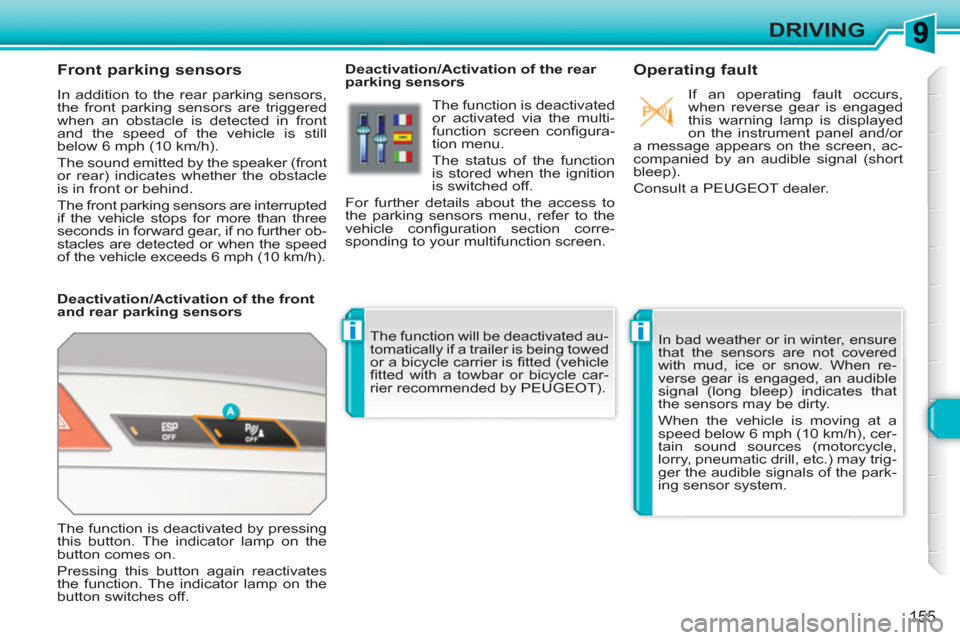
ii
155
DRIVING
Front parking sensors
In addition to the rear parking sensors,
the front parking sensors are triggered
when an obstacle is detected in front
and the speed of the vehicle is still
below 6 mph (10 km/h).
The sound emitted by the speaker (front
or rear) indicates whether the obstacle
is in front or behind.
The front parking sensors are interrupted
if the vehicle stops for more than three
seconds in forward gear, if no further ob-
stacles are detected or when the speed
of the vehicle exceeds 6 mph (10 km/h).
Deactivation/Activation of the front
and rear parking sensors
Deactivation/Activation of the rear
parking sensors
The function will be deactivated au-
tomatically if a trailer is being towed
or a bicycle carrier is fi tted (vehicle
fi tted with a towbar or bicycle car-
rier recommended by PEUGEOT).
Operating fault
In bad weather or in winter, ensure
that the sensors are not covered
with mud, ice or snow. When re-
verse gear is engaged, an audible
signal (long bleep) indicates that
the sensors may be dirty.
When the vehicle is moving at a
speed below 6 mph (10 km/h), cer-
tain sound sources (motorcycle,
lorry, pneumatic drill, etc.) may trig-
ger the audible signals of the park-
ing sensor system.
The function is deactivated by pressing
this button. The indicator lamp on the
button comes on.
Pressing this button again reactivates
the function. The indicator lamp on the
button switches off.
The function is deactivated
or activated via the multi-
function screen confi gura-
tion menu.
The status of the function
is stored when the ignition
is switched off.
For further details about the access to
the parking sensors menu, refer to the
vehicle confi guration section corre-
sponding to your multifunction screen.
If an operating fault occurs,
when reverse gear is engaged
this warning lamp is displayed
on the instrument panel and/or
a message appears on the screen, ac-
companied by an audible signal (short
bleep).
Consult a PEUGEOT dealer.
Page 158 of 336
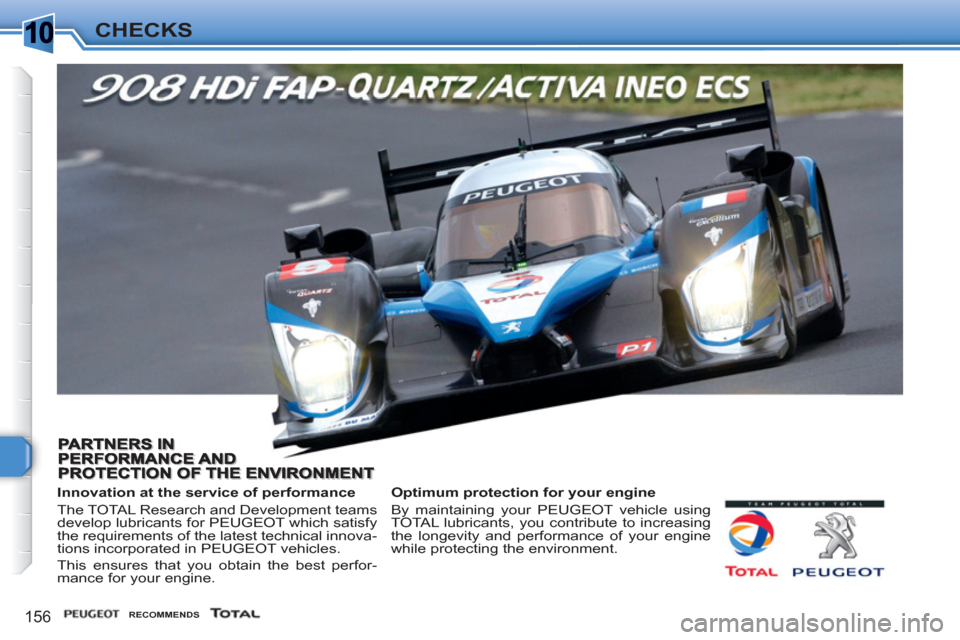
1
156
CHECKS
Optimum protection for your engine
By maintaining your PEUGEOT vehicle using
TOTAL lubricants, you contribute to increasing
the longevity and performance of your engine
while protecting the environment.
Innovation at the service of performance
The TOTAL Research and Development teams
develop lubricants for PEUGEOT which satisfy
the requirements of the latest technical innova-
tions incorporated in PEUGEOT vehicles.
This ensures that you obtain the best perfor-
mance for your engine.
RECOMMENDS
Page 159 of 336
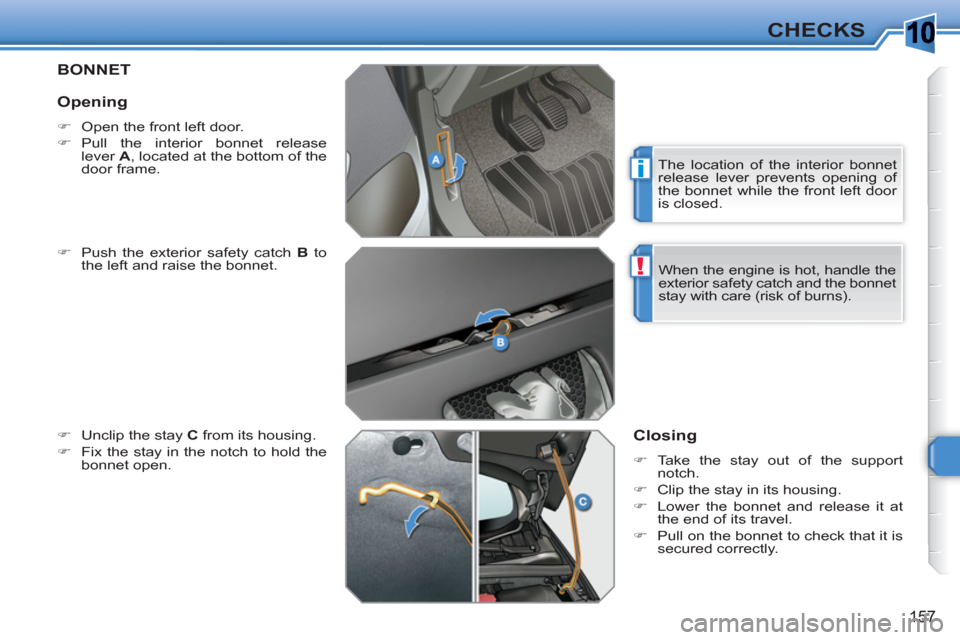
10
i
!
157
CHECKS
BONNET
�)
Push the exterior safety catch B
to
the left and raise the bonnet.
�)
Unclip the stay C
from its housing.
�)
Fix the stay in the notch to hold the
bonnet open.
Closing
�)
Take the stay out of the support
notch.
�)
Clip the stay in its housing.
�)
Lower the bonnet and release it at
the end of its travel.
�)
Pull on the bonnet to check that it is
secured correctly.
Opening
�)
Open the front left door.
�)
Pull the interior bonnet release
lever A
, located at the bottom of the
door frame. The location of the interior bonnet
release lever prevents opening of
the bonnet while the front left door
is closed.
When the engine is hot, handle the
exterior safety catch and the bonnet
stay with care (risk of burns).
Page 160 of 336
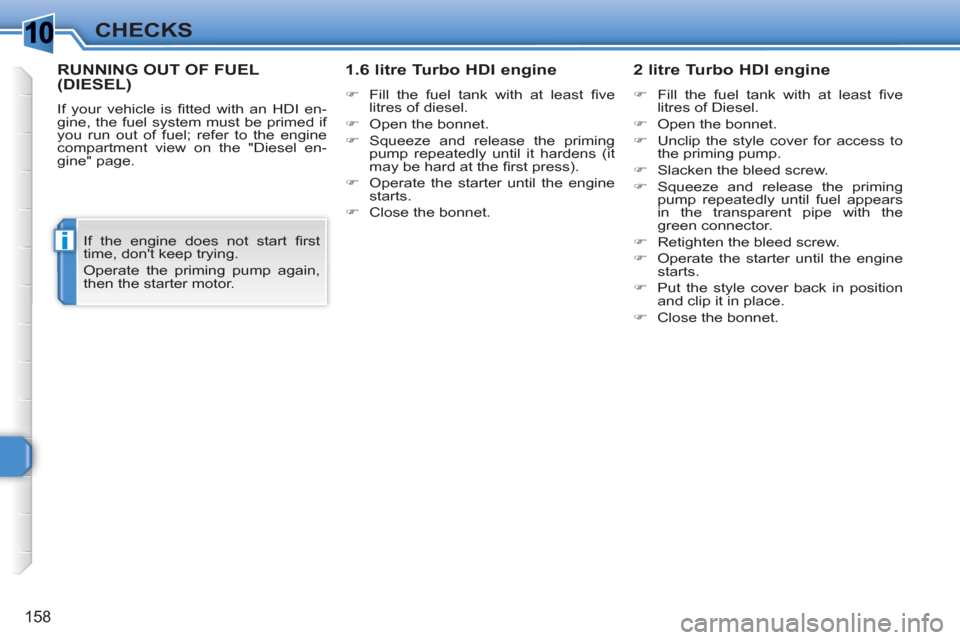
1
i
158
CHECKS
RUNNING OUT OF FUEL (DIESEL)
If your vehicle is fi tted with an HDI en-
gine, the fuel system must be primed if
you run out of fuel; refer to the engine
compartment view on the "Diesel en-
gine" page.
1.6 litre Turbo HDI engine
�)
Fill the fuel tank with at least fi ve
litres of diesel.
�)
Open the bonnet.
�)
Squeeze and release the priming
pump repeatedly until it hardens (it
may be hard at the fi rst press).
�)
Operate the starter until the engine
starts.
�)
Close the bonnet.
2 litre Turbo HDI engine
�)
Fill the fuel tank with at least fi ve
litres of Diesel.
�)
Open the bonnet.
�)
Unclip the style cover for access to
the priming pump.
�)
Slacken the bleed screw.
�)
Squeeze and release the priming
pump repeatedly until fuel appears
in the transparent pipe with the
green connector.
�)
Retighten the bleed screw.
�)
Operate the starter until the engine
starts.
�)
Put the style cover back in position
and clip it in place.
�)
Close the bonnet.
If the engine does not start fi rst
time, don't keep trying.
Operate the priming pump again,
then the starter motor.